Conceptual art
Conceptual art, also referred to as conceptualism, is art in which the concept(s) or idea(s) involved in the work take precedence over traditional aesthetic, technical, and material concerns. Some works of conceptual art, sometimes called installations, may be constructed by anyone simply by following a set of written instructions.[1] This method was fundamental to American artist Sol LeWitt's definition of conceptual art, one of the first to appear in print:
In conceptual art the idea or concept is the most important aspect of the work. When an artist uses a conceptual form of art, it means that all of the planning and decisions are made beforehand and the execution is a perfunctory affair. The idea becomes a machine that makes the art.[2]
Tony Godfrey, author of Conceptual Art (Art & Ideas) (1998), asserts that conceptual art questions the nature of art,[3] a notion that Joseph Kosuth elevated to a definition of art itself in his seminal, early manifesto of conceptual art, Art after Philosophy (1969). The notion that art should examine its own nature was already a potent aspect of the influential art critic Clement Greenberg's vision of Modern art during the 1950s. With the emergence of an exclusively language-based art in the 1960s, however, conceptual artists such as Art & Language, Joseph Kosuth (who became the American editor of Art-Language), and Lawrence Weiner began a far more radical interrogation of art than was previously possible (see below). One of the first and most important things they questioned was the common assumption that the role of the artist was to create special kinds of material objects.[4][5][6]
Through its association with the Young British Artists and the Turner Prize during the 1990s, in popular usage, particularly in the United Kingdom, "conceptual art" came to denote all contemporary art that does not practice the traditional skills of painting and sculpture.[7] It could be said that one of the reasons why the term "conceptual art" has come to be associated with various contemporary practices far removed from its original aims and forms lies in the problem of defining the term itself. As the artist Mel Bochner suggested as early as 1970, in explaining why he does not like the epithet "conceptual", it is not always entirely clear what "concept" refers to, and it runs the risk of being confused with "intention". Thus, in describing or defining a work of art as conceptual it is important not to confuse what is referred to as "conceptual" with an artist's "intention".
History
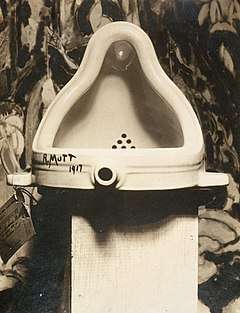
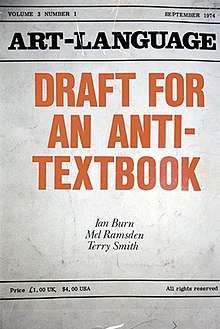
The French artist Marcel Duchamp paved the way for the conceptualists, providing them with examples of prototypically conceptual works — the readymades, for instance. The most famous of Duchamp's readymades was Fountain (1917), a standard urinal-basin signed by the artist with the pseudonym "R.Mutt", and submitted for inclusion in the annual, un-juried exhibition of the Society of Independent Artists in New York (which rejected it).[8] The artistic tradition does not see a commonplace object (such as a urinal) as art because it is not made by an artist or with any intention of being art, nor is it unique or hand-crafted. Duchamp's relevance and theoretical importance for future "conceptualists" was later acknowledged by US artist Joseph Kosuth in his 1969 essay, Art after Philosophy, when he wrote: "All art (after Duchamp) is conceptual (in nature) because art only exists conceptually".
In 1956 the founder of Lettrism, Isidore Isou, developed the notion of a work of art which, by its very nature, could never be created in reality, but which could nevertheless provide aesthetic rewards by being contemplated intellectually. This concept, also called Art esthapériste (or "infinite-aesthetics"), derived from the infinitesimals of Gottfried Wilhelm Leibniz – quantities which could not actually exist except conceptually. The current incarnation (As of 2013) of the Isouian movement, Excoördism, self-defines as the art of the infinitely large and the infinitely small.
In 1961 the term "concept art", coined by the artist Henry Flynt in his article bearing the term as its title, appeared in a proto-Fluxus publication An Anthology of Chance Operations.[9] However, it assumed a different meaning when employed by Joseph Kosuth and by the English Art and Language group, who discarded the conventional art object in favour of a documented critical inquiry, that began in Art-Language The Journal of conceptual art in 1969, into the artist's social, philosophical, and psychological status. By the mid-1970s they had produced publications, indices, performances, texts and paintings to this end. In 1970 Conceptual Art and Conceptual Aspects, the first dedicated conceptual-art exhibition, took place at the New York Cultural Center.[10]
The critique of formalism and of the commodification of art
Conceptual art emerged as a movement during the 1960s – in part as a reaction against formalism as then articulated by the influential New York art critic Clement Greenberg. According to Greenberg Modern art followed a process of progressive reduction and refinement toward the goal of defining the essential, formal nature of each medium. Those elements that ran counter to this nature were to be reduced. The task of painting, for example, was to define precisely what kind of object a painting truly is: what makes it a painting and nothing else. As it is of the nature of paintings to be flat objects with canvas surfaces onto which colored pigment is applied, such things as figuration, 3-D perspective illusion and references to external subject matter were all found to be extraneous to the essence of painting, and ought to be removed.[11]
Some have argued that conceptual art continued this "dematerialization" of art by removing the need for objects altogether,[12] while others, including many of the artists themselves, saw conceptual art as a radical break with Greenberg's kind of formalist Modernism. Later artists continued to share a preference for art to be self-critical, as well as a distaste for illusion. However, by the end of the 1960s it was certainly clear that Greenberg's stipulations for art to continue within the confines of each medium and to exclude external subject matter no longer held traction.[13] Conceptual art also reacted against the commodification of art; it attempted a subversion of the gallery or museum as the location and determiner of art, and the art market as the owner and distributor of art. Lawrence Weiner said: "Once you know about a work of mine you own it. There's no way I can climb inside somebody's head and remove it." Many conceptual artists' work can therefore only be known about through documentation which is manifested by it, e.g. photographs, written texts or displayed objects, which some might argue are not in themselves the art. It is sometimes (as in the work of Robert Barry, Yoko Ono, and Weiner himself) reduced to a set of written instructions describing a work, but stopping short of actually making it—emphasising the idea as more important than the artifact. This reveals an explicit preference for the "art" side of the ostensible dichotomy between art and craft, where art, unlike craft, takes place within and engages historical discourse: for example, Ono's "written instructions" make more sense alongside other conceptual art of the time.
Language and/as art
Language was a central concern for the first wave of conceptual artists of the 1960s and early 1970s. Although the utilisation of text in art was in no way novel, only in the 1960s did the artists Lawrence Weiner, Edward Ruscha,[14] Joseph Kosuth, Robert Barry, and Art & Language begin to produce art by exclusively linguistic means. Where previously language was presented as one kind of visual element alongside others, and subordinate to an overarching composition (e.g. Synthetic Cubism), the conceptual artists used language in place of brush and canvas, and allowed it to signify in its own right.[15] Of Lawrence Weiner's works Anne Rorimer writes, "The thematic content of individual works derives solely from the import of the language employed, while presentational means and contextual placement play crucial, yet separate, roles."[16]
The British philosopher and theorist of conceptual art Peter Osborne suggests that among the many factors that influenced the gravitation toward language-based art, a central role for conceptualism came from the turn to linguistic theories of meaning in both Anglo-American analytic philosophy, and structuralist and post structuralist Continental philosophy during the middle of the twentieth century. This linguistic turn "reinforced and legitimized" the direction the conceptual artists took.[17] Osborne also notes that the early conceptualists were the first generation of artists to complete degree-based university training in art.[18] Osborne later made the observation that contemporary art is post-conceptual[19] in a public lecture delivered at the Fondazione Antonio Ratti, Villa Sucota in Como on July 9, 2010. It is a claim made at the level of the ontology of the work of art (rather than say at the descriptive level of style or movement).
The American art historian Edward A. Shanken points to the example of Roy Ascott who "powerfully demonstrates the significant intersections between conceptual art and art-and-technology, exploding the conventional autonomy of these art-historical categories." Ascott, the British artist most closely associated with cybernetic art in England, was not included in Cybernetic Serendipity because his use of cybernetics was primarily conceptual and did not explicitly utilize technology. Conversely, although his essay on the application of cybernetics to art and art pedagogy, "The Construction of Change" (1964), was quoted on the dedication page (to Sol Lewitt) of Lucy R. Lippard's seminal Six Years: The Dematerialization of the Art Object from 1966 to 1972, Ascott's anticipation of and contribution to the formation of conceptual art in Britain has received scant recognition, perhaps (and ironically) because his work was too closely allied with art-and-technology. Another vital intersection was explored in Ascott's use of the thesaurus in 1963 , which drew an explicit parallel between the taxonomic qualities of verbal and visual languages – a concept would be taken up in Joseph Kosuth's Second Investigation, Proposition 1 (1968) and Mel Ramsden's Elements of an Incomplete Map (1968).
Conceptual art and artistic skill
.jpg)
By adopting language as their exclusive medium, Weiner, Barry, Wilson, Kosuth and Art & Language were able to sweep aside the vestiges of authorial presence manifested by formal invention and the handling of materials.[16]
An important difference between conceptual art and more "traditional" forms of art-making goes to the question of artistic skill. Although skill in the handling of traditional media often plays little role in conceptual art, it is difficult to argue that no skill is required to make conceptual works, or that skill is always absent from them. John Baldessari, for instance, has presented realist pictures that he commissioned professional sign-writers to paint; and many conceptual performance artists (e.g. Stelarc, Marina Abramović) are technically accomplished performers and skilled manipulators of their own bodies. It is thus not so much an absence of skill or hostility toward tradition that defines conceptual art as an evident disregard for conventional, modern notions of authorial presence and of individual artistic expression.
Contemporary influence
Proto-conceptualism has roots in the rise of Modernism with, for example, Manet (1832–1883) and later Marcel Duchamp (1887–1968). The first wave of the "conceptual art" movement extended from approximately 1967[20] to 1978. Early "concept" artists like Henry Flynt (1940– ), Robert Morris (1931–2018), and Ray Johnson (1927–1995) influenced the later, widely accepted movement of conceptual art. Conceptual artists like Dan Graham, Hans Haacke, and Lawrence Weiner have proven very influential on subsequent artists, and well-known contemporary artists such as Mike Kelley or Tracey Emin are sometimes labeled "second- or third-generation" conceptualists, or "post-conceptual" artists (the prefix Post- in art can frequently be interpreted as "because of").
Contemporary artists have taken up many of the concerns of the conceptual art movement, while they may or may not term themselves "conceptual artists". Ideas such as anti-commodification, social and/or political critique, and ideas/information as medium continue to be aspects of contemporary art, especially among artists working with installation art, performance art, net.art and electronic/digital art.[21]
Notable examples
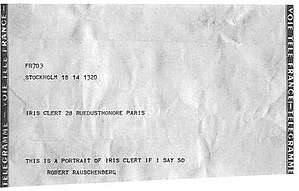
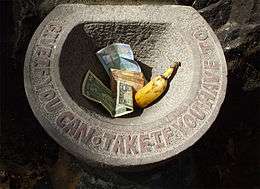
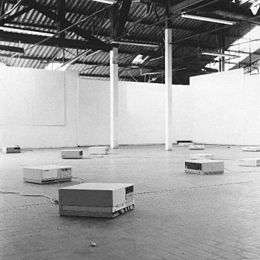
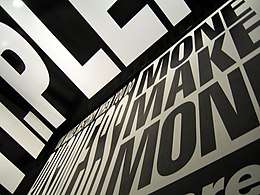
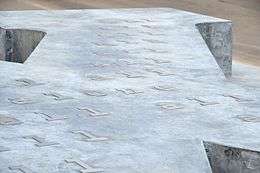
- 1917 : Fountain by Marcel Duchamp, described in an article in The Independent as the invention of conceptual art.[22]
- 1953 : Robert Rauschenberg creates Erased De Kooning Drawing, a drawing by Willem de Kooning which Rauschenberg erased. It raised many questions about the fundamental nature of art, challenging the viewer to consider whether erasing another artist's work could be a creative act, as well as whether the work was only "art" because the famous Rauschenberg had done it.
- 1955 : Rhea Sue Sanders creates her first text pieces of the series pièces de complices, combining visual art with poetry and philosophy, and introducing the concept of complicity: the viewer must accomplish the art in her/his imagination.[23]
- 1956 : Isidore Isou introduces the concept of infinitesimal art in Introduction à une esthétique imaginaire (Introduction to Imaginary Aesthetics).
- 1957: Yves Klein, Aerostatic Sculpture (Paris). This was composed of 1001 blue balloons released into the sky from Galerie Iris Clert to promote his Proposition Monochrome; Blue Epoch exhibition. Klein also exhibited 'One Minute Fire Painting' which was a blue panel into which 16 firecrackers were set. For his next major exhibition, The Void in 1958, Klein declared that his paintings were now invisible and to prove it he exhibited an empty room.
- 1958: Wolf Vostell Das Theater ist auf der Straße/The theater is on the street. The first Happening in Europe.[24]
- 1960: Yves Klein's action called A Leap Into The Void, in which he attempts to fly by leaping out of a window. He stated: "The painter has only to create one masterpiece, himself, constantly."
- 1960: The artist Stanley Brouwn declares that all the shoe shops in Amsterdam constitute an exhibition of his work.
- 1961: Wolf Vostell Cityrama, in Cologne was the first Happening in Germany.
- 1961: Robert Rauschenberg sent a telegram to the Galerie Iris Clert which said: 'This is a portrait of Iris Clert if I say so.' as his contribution to an exhibition of portraits.
- 1961: Piero Manzoni exhibited Artist's Shit, tins purportedly containing his own feces (although since the work would be destroyed if opened, no one has been able to say for sure). He put the tins on sale for their own weight in gold. He also sold his own breath (enclosed in balloons) as Bodies of Air, and signed people's bodies, thus declaring them to be living works of art either for all time or for specified periods. (This depended on how much they are prepared to pay). Marcel Broodthaers and Primo Levi are amongst the designated 'artworks'.
- 1962: Artist Barrie Bates rebrands himself as Billy Apple, erasing his original identity to continue his exploration of everyday life and commerce as art. By this stage, many of his works are fabricated by third parties.[25]
- 1962: Christo's Iron Curtain work. This consists of a barricade of oil barrels in a narrow Paris street which caused a large traffic jam. The artwork was not the barricade itself but the resulting traffic jam.
- 1962: Yves Klein presents Immaterial Pictorial Sensitivity in various ceremonies on the banks of the Seine. He offers to sell his own 'pictorial sensitivity' (whatever that was, he did not define it) in exchange for gold leaf. In these ceremonies the purchaser gave Klein the gold leaf in return for a certificate. Since Klein's sensitivity was immaterial, the purchaser was then required to burn the certificate whilst Klein threw half the gold leaf into the Seine. (There were seven purchasers.)
- 1962: Piero Manzoni created The Base of the World, thereby exhibiting the entire planet as his artwork.
- 1962: Alberto Greco began his Vivo Dito or Live Art series, which took place in Paris, Rome, Madrid, and Piedralaves. In each artwork, Greco called attention to the art in everyday life, thereby asserting that art was actually a process of looking and seeing.
- 1962: FLUXUS Internationale Festspiele Neuester Musik in Wiesbaden with, George Maciunas, Wolf Vostell, Nam June Paik and others.[26]
- 1963: George Brecht's collection of Event-Scores, Water Yam, is published as the first Fluxkit by George Maciunas.
- 1963: Festum Fluxorum Fluxus in Düsseldorf with George Maciunas, Wolf Vostell, Joseph Beuys, Dick Higgins, Nam June Paik, Ben Patterson, Emmett Williams and others.
- 1963: Henry Flynt's article Concept Art is published in An Anthology of Chance Operations; a collection of artworks and concepts by artists and musicians that was published by Jackson Mac Low and La Monte Young (ed.). An Anthology of Chance Operations documented the development of Dick Higgins vision of intermedia art in the context of the ideas of John Cage and became an early Fluxus masterpiece. Flynt's "concept art" devolved from his idea of "cognitive nihilism" and from his insights about the vulnerabilities of logic and mathematics.
- 1964: Yoko Ono publishes Grapefruit: A Book of Instructions and Drawings. An example of Heuristic art, or a series of instructions for how to obtain an aesthetic experience.
- 1965: Art & Language founder Michael Baldwin Mirror Piece. Instead of paintings, the work is showing a variable number of mirrors that challenge both the visitor and Clement Greenberg theory.[27]
- 1965: A complex conceptual art piece by John Latham called Still and Chew. He invites art students to protest against the values of Clement Greenberg's Art and Culture, much praised and taught at Saint Martin's School of Art in London, where Latham taught part-time. Pages of Greenberg's book (borrowed from the college library) are chewed by the students, dissolved in acid and the resulting solution returned to the library bottled and labelled. Latham was then fired from his part-time position.
- 1965: with Show V, immaterial sculpture the Dutch artist Marinus Boezem introduced Conceptual Art in the Netherlands. In the show various air doors are placed where people can walk through them. People have the sensory experience of warmth, air. Three invisible air doors, which arise as currents of cold and warm are blown into the room, are indicated in the space with bundles of arrows and lines. The articulation of the space which arises is the result of invisible processes which influence the conduct of persons in that space, and who are included in the system as co-performers.
- Joseph Kosuth dates the concept of One and Three Chairs in the year 1965. The presentation of the work consists of a chair, its photo and a blow up of a definition of the word "chair". Kosuth has chosen the definition from a dictionary. Four versions with different definitions are known.
- 1966: Conceived in 1966 The Air Conditioning Show of Art & Language is published as an article in 1967 in the November issue of Arts Magazine.[28]
- 1966: N.E. Thing Co. Ltd. (Iain and Ingrid Baxter of Vancouver) exhibited Bagged Place the contents of a four-room apartment wrapped in plastic bags. The same year they registered as a corporation and subsequently organized their practice along corporate models, one of the first international examples of the "aesthetic of administration".
- 1967: Mel Ramsden first 100% Abstract Paintings. The painting shows a list of chemical components that constitute the substance of the painting.[29]
- 1967: Sol LeWitt's Paragraphs on Conceptual Art were published by the American art journal Artforum. The Paragraphs mark the progression from Minimal to Conceptual Art.
- 1968: Michael Baldwin, Terry Atkinson, David Bainbridge and Harold Hurrell found Art & Language.[30]
- 1968: Lawrence Weiner relinquishes the physical making of his work and formulates his "Declaration of Intent", one of the most important conceptual art statements following LeWitt's "Paragraphs on Conceptual Art." The declaration, which underscores his subsequent practice reads: "1. The artist may construct the piece. 2. The piece may be fabricated. 3. The piece need not be built. Each being equal and consistent with the intent of the artist the decision as to condition rests with the receiver upon the occasion of receivership."
- Friedrich Heubach launches the magazine Interfunktionen in Cologne, Germany, a publication that excelled in artists' projects. It originally showed a Fluxus influence, but later moved toward Conceptual art.
- 1969: The first generation of New York alternative exhibition spaces are established, including Billy Apple's APPLE, Robert Newman's Gain Ground, where Vito Acconci produced many important early works, and 112 Greene Street.[25][31]
- 1969: Robert Barry's Telepathic Piece at Simon Fraser University, Vancouver, of which he said 'During the exhibition I will try to communicate telepathically a work of art, the nature of which is a series of thoughts that are not applicable to language or image'.
- 1969: The first issue of Art-Language The Journal of conceptual art is published in May. It is subtitled as The Journal of conceptual art and edited by Terry Atkinson, David Bainbridge, Michael Baldwin and Harold Hurrell. Art & Language are the editors of this first number, and by the second number and until 1972, Joseph Kosuth will join and become the American editor.
- 1969: Vito Acconci creates Following Piece, in which he follows randomly selected members of the public until they disappear into a private space. The piece is presented as photographs.
- The English journal Studio International published Joseph Kosuth´s article "Art after Philosophy" in three parts (October–December). It became the most discussed article on "Conceptual Art".
- 1970: Ian Burn, Mel Ramsden and Charles Harrison join Art & Language.[30]
- 1970: Painter John Baldessari exhibits a film in which he sets a series of erudite statements by Sol LeWitt on the subject of conceptual art to popular tunes like "Camptown Races" and "Some Enchanted Evening".
- 1970: Douglas Huebler exhibits a series of photographs which were taken every two minutes whilst driving along a road for 24 minutes.
- 1970: Douglas Huebler asks museum visitors to write down 'one authentic secret'. The resulting 1800 documents are compiled into a book which, by some accounts, makes for very repetitive reading as most secrets are similar.
- 1971: Hans Haacke's Real Time Social System. This piece of systems art detailed the real estate holdings of the third largest landowners in New York City. The properties were mostly in Harlem and the Lower East Side, were decrepit and poorly maintained, and represented the largest concentration of real estate in those areas under the control of a single group. The captions gave various financial details about the buildings, including recent sales between companies owned or controlled by the same family. The Guggenheim museum cancelled the exhibition, stating that the overt political implications of the work constituted "an alien substance that had entered the art museum organism". There is no evidence to suggest that the trustees of the Guggenheim were linked financially to the family which was the subject of the work.
- 1972: The Art & Language Institute exhibits Index 01 at the Documenta 5, an installation indexing text-works by Art & Language and text-works from Art-Language.
- 1972: Antonio Caro exhibits in the National Art Salon (Museo Nacional, Bogotá, Colombia) his work: Aquinocabeelarte (Art does not fit here), where each of the letters is a separate poster, and under each letter is written the name of some victim of state repression.
- 1972: Fred Forest buys an area of blank space in the newspaper Le Monde and invites readers to fill it with their own works of art.
- General Idea launch File magazine in Toronto. The magazine functioned as something of an extended, collaborative artwork.
- 1973: Jacek Tylicki lays out blank canvases or paper sheets in the natural environment for the nature to create art.
- 1974: Cadillac Ranch near Amarillo, Texas.
- 1975–76: Three issues of the journal The Fox were published by Art & Language in New York by. The editor was Joseph Kosuth. The Fox became an important platform for the American members of Art & Language. Karl Beveridge, Ian Burn, Sarah Charlesworth, Michael Corris, Joseph Kosuth, Andrew Menard, Mel Ramsden and Terry Smith wrote articles which thematized the context of contemporary art. These articles exemplify the development of an institutional critique within the inner circle of Conceptual Art. The criticism of the art world integrates social, political and economic reasons.
- 1975-77 Orshi Drozdik's Individual Mythology performance, photography and offsetprint series and her theory of ImageBank in Budapest.
- 1976: facing internal problems, members of Art & Language separate. The destiny of the name Art & Language remaining in Michael Baldwin, Mel Ramsden and Charles Harrison hands.
- 1977: Walter De Maria's Vertical Earth Kilometer in Kassel, Germany. This was a one kilometer brass rod which was sunk into the earth so that nothing remained visible except a few centimeters. Despite its size, therefore, this work exists mostly in the viewer's mind.
- 1982: The opera Victorine by Art & Language was to be performed in the city of Kassel for documenta 7 and shown alongside Art & Language Studio at 3 Wesley Place Painted by Actors, but the performance was cancelled.[32]
- 1986: Art & Language are nominated for the Turner Prize.
- 1989: Christopher Williams' Angola to Vietnam is first exhibited. The work consists of a series of black-and-white photographs of glass botanical specimens from the Botanical Museum at Harvard University, chosen according to a list of the thirty-six countries in which political disappearances were known to have taken place during the year 1985.
- 1990: Ashley Bickerton and Ronald Jones included in "Mind Over Matter: Concept and Object" exhibition of ”third generation Conceptual artists” at the Whitney Museum of American Art.[33]
- 1991: Ronald Jones exhibits objects and text, art, history and science rooted in grim political reality at Metro Pictures Gallery.[34]
- 1991: Charles Saatchi funds Damien Hirst and the next year in the Saatchi Gallery exhibits his The Physical Impossibility of Death in the Mind of Someone Living, a shark in formaldehyde in a vitrine.
- 1992: Maurizio Bolognini starts to "seal" his Programmed Machines: hundreds of computers are programmed and left to run ad infinitum to generate inexhaustible flows of random images which nobody would see.[35]
- 1993: Matthieu Laurette established his artistic birth certificate by taking part in a French TV game called Tournez manège (The Dating Game) where the female presenter asked him who he was, to which he replied: 'A multimedia artist'. Laurette had sent out invitations to an art audience to view the show on TV from their home, turning his staging of the artist into a performed reality.
- 1993: Vanessa Beecroft holds her first performance in Milan, Italy, using models to act as a second audience to the display of her diary of food.
- 1999: Tracey Emin is nominated for the Turner Prize. Part of her exhibit is My Bed, her dishevelled bed, surrounded by detritus such as condoms, blood-stained knickers, bottles and her bedroom slippers.
- 2001: Martin Creed wins the Turner Prize for The Lights Going On and Off, an empty room in which the lights go on and off.[36]
- 2004: Andrea Fraser's video Untitled, a document of her sexual encounter in a hotel room with a collector (the collector having agreed to help finance the technical costs for enacting and filming the encounter) is exhibited at the Friedrich Petzel Gallery. It is accompanied by her 1993 work Don't Postpone Joy, or Collecting Can Be Fun, a 27-page transcript of an interview with a collector in which the majority of the text has been deleted.
- 2005: Simon Starling wins the Turner Prize for Shedboatshed, a wooden shed which he had turned into a boat, floated down the Rhine and turned back into a shed again.[37]
- 2005: Maurizio Nannucci creates the large neon installation All Art Has Been Contemporary on the facade of Altes Museum in Berlin.
- 2014: Olaf Nicolai creates the Memorial for the Victims of Nazi Military Justice on Vienna's Ballhausplatz after winning an international competition. The inscription on top of the three-step sculpture features a poem by Scottish poet Ian Hamilton Finlay (1924–2006) with just two words: all alone.
- 2020: Shaun O’Boyle creates the Conceptual art in digital perspective on Twitter[38].
Notable conceptual artists
- Kevin Abosch
- Vito Acconci
- Bas Jan Ader
- Vikky Alexander
- Francis Alÿs
- Keith Arnatt
- Art & Language
- Roy Ascott
- Marina Abramović
- Billy Apple
- Shusaku Arakawa
- Christopher D'Arcangelo
- Michael Asher
- Mireille Astore
- Abel Azcona
- John Baldessari
- Adina Bar-On
- NatHalie Braun Barends
- Artur Barrio
- Robert Barry
- Lothar Baumgarten
- Joseph Beuys
- Adolf Bierbrauer
- Mel Bochner
- Marinus Boezem
- Maurizio Bolognini
- Allan Bridge
- Marcel Broodthaers
- Chris Burden
- Daniel Buren
- Victor Burgin
- Donald Burgy
- John Cage
- Cai Guo-Qiang
- Sophie Calle
- Roberto Chabet
- Greg Colson
- Martin Creed
- Cory Danziger
- Jack Daws
- Jeremy Deller
- Agnes Denes
- Jan Dibbets
- Mark Divo
- Brad Downey
- Marcel Duchamp
- Olafur Eliasson
- Ken Feingold
- Teresita Fernández
- Fluxus
- Henry Flynt
- Andrea Fraser
- Jens Galschiøt
- Kendell Geers
- Thierry Geoffroy
- Jochen Gerz
- Gilbert and George
- Manav Gupta
- Felix Gonzalez-Torres
- Allan Graham
- Dan Graham
- Hans Haacke
- Iris Häussler
- Irma Hünerfauth
- Oliver Herring
- Andreas Heusser
- Jenny Holzer
- Greer Honeywill
- Zhang Huan
- Douglas Huebler
- General Idea
- David Ireland
- Alfredo Jaar
- Ray Johnson
- Ronald Jones
- Ilya Kabakov
- On Kawara
- Jonathon Keats
- Mary Kelly
- Yves Klein
- John Knight (artist)
- Joseph Kosuth
- Barbara Kruger
- Yayoi Kusama
- John Latham
- Matthieu Laurette
- Sol LeWitt
- Annette Lemieux
- Elliott Linwood
- Noah Lyon
- Richard Long
- Mark Lombardi
- George Maciunas
- Piero Manzoni
- Tom Marioni
- Phyllis Mark
- Danny Matthys
- Allan McCollum
- Cildo Meireles
- Marta Minujín
- Linda Montano
- Robert Morris (artist)
- N.E. Thing Co. Ltd. (Iain & Ingrid Baxter)
- Maurizio Nannucci
- Bruce Nauman
- Olaf Nicolai
- Margaret Noble
- Yoko Ono
- Roman Opałka
- Dennis Oppenheim
- Adrian Piper
- William Pope.L
- Dmitri Prigov
- Guillem Ramos-Poquí
- Charles Recher
- Jim Ricks
- Martha Rosler
- Allen Ruppersberg
- Santiago Sierra
- Bodo Sperling
- Stelarc
- M. Vänçi Stirnemann
- Hiroshi Sugimoto
- Stephanie Syjuco
- Hakan Topal
- Endre Tot
- Jacek Tylicki
- Mierle Laderman Ukeles
- Wolf Vostell
- Mark Wallinger
- Gillian Wearing
- Peter Weibel
- Lawrence Weiner
- Roger Welch
- Christopher Williams
- xurban collective
- Industry of the Ordinary
- Arne Quinze
See also
- Post-conceptualism
- Anti-art
- Anti-anti-art
- Body art
- Classificatory disputes about art
- Conceptual architecture
- Contemporary art
- Danger music
- Experiments in Art and Technology
- Found object
- Gutai group
- Happening
- Fluxus
- Information art
- Installation art
- Intermedia
- Land art
- Modern art
- Moscow Conceptualists
- Neo-conceptual art
- Olfactory art
- Net art
- Postmodern art
- Relational art
- Generative Art
- Street installation
- Something Else Press
- Systems art
- Video art
- Visual arts
- ART/MEDIA
Individual works
- Fountain
- One and Three Chairs
- The Bride Stripped Bare By Her Bachelors, Even
- Mirror Piece
- Secret Painting
- Victorine
Notes and references
- "Wall Drawing 811 – Sol LeWitt". Archived from the original on 2 March 2007.
- Sol LeWitt "Paragraphs on Conceptual Art", Artforum, June 1967.
- Godrey, Tony (1988). Conceptual Art (Art & Ideas). London: Phaidon Press Ltd. ISBN 978-0-7148-3388-0.
- Joseph Kosuth, Art After Philosophy (1969). Reprinted in Peter Osborne, Conceptual Art: Themes and Movements, Phaidon, London, 2002. p. 232
- Art & Language, Art-Language The Journal of conceptual art: Introduction (1969). Reprinted in Osborne (2002) p. 230
- Ian Burn, Mel Ramsden: "Notes On Analysis" (1970). Reprinted in Osborne (2003), p. 237. E.g. "The outcome of much of the 'conceptual' work of the past two years has been to carefully clear the air of objects."
- "Turner Prize history: Conceptual art". Tate Gallery. tate.org.uk. Accessed August 8, 2006
- Tony Godfrey, Conceptual Art, London: 1998. p. 28
- "Essay: Concept Art".
- Artlex.com Archived 2013-05-16 at the Wayback Machine
- Rorimer, p. 11
- Lucy Lippard & John Chandler, "The Dematerialization of Art", Art International 12:2, February 1968. Reprinted in Osborne (2002), p. 218
- Rorimer, p. 12
- "Ed Ruscha and Photography". The Art Institute of Chicago. 1 March – 1 June 2008. Archived from the original on 31 May 2010. Retrieved 14 September 2010.
- Anne Rorimer, New Art in the Sixties and Seventies, Thames & Hudson, 2001; p. 71
- Rorimer, p. 76
- Peter Osborne, Conceptual Art: Themes and movements, Phaidon, London, 2002. p. 28
- Osborne (2002), p. 28
- http://www.fondazioneratti.org/mat/mostre/Contemporary%20art%20is%20post-conceptual%20art%20/Leggi%20il%20testo%20della%20conferenza%20di%20Peter%20Osborne%20in%20PDF.pdf
- Conceptual Art – "In 1967, Sol LeWitt published Paragraphs on Conceptual Art (considered by many to be the movement's manifesto) [...]."
- "Conceptual Art – The Art Story". theartstory.org. The Art Story Foundation. Retrieved 25 September 2014.
- Hensher, Philip (2008-02-20). "The loo that shook the world: Duchamp, Man Ray, Picabi". London: The Independent (Extra). pp. 2–5.
- Bénédicte Demelas: Des mythes et des réalitées de l'avant-garde française. Presses universitaires de Rennes, 1988
- ChewingTheSun. "Vorschau – Museum Morsbroich".
- Byrt, Anthony. "Brand, new". Frieze Magazine. Retrieved 28 November 2012.
- Fluxus at 50. Stefan Fricke, Alexander Klar, Sarah Maske, Kerber Verlag, 2012, ISBN 978-3-86678-700-1.
- Tate (2016-04-22), Art & Language – Conceptual Art, Mirrors and Selfies | TateShots, retrieved 2017-07-29
- "Air-Conditioning Show / Air Show / Frameworks 1966–67". www.macba.cat. Archived from the original on 2017-07-29. Retrieved 2017-07-29.
- "ART & LANGUAGE UNCOMPLETED". www.macba.cat. Retrieved 2017-07-29.
- "BBC – Coventry and Warwickshire Culture – Art and Language". www.bbc.co.uk. Retrieved 2017-07-29.
- Terroni, Christelle. "The Rise and Fall of Alternative Spaces". books&ideas.net. Retrieved 28 November 2012.
- Charles Harison (2001). Conceptual art and painting Further essays on Art & Language. Cambridge: The MIT Press. p. 58. ISBN 0-262-58240-6..
- Brenson, Michael (19 October 1990). "Review/Art; In the Arena of the Mind, at the Whitney". The New York Times.
- Smith, Roberta. "Art in review: Ronald Jones Metro Pictures", The New York Times, 27 December 1991. Retrieved 8 July 2008.
- Sandra Solimano (ed.) (2005). Maurizio Bolognini. Programmed Machines 1990–2005. Genoa: Villa Croce Museum of Contemporary Art, Neos. ISBN 88-87262-47-0.CS1 maint: extra text: authors list (link)
- "BBC News – ARTS – Creed lights up Turner prize".
- "The Times & The Sunday Times".
- "Dr Shaun O'Boyle - Did it work?".
Further reading
Books
- Charles Harrison, Essays on Art & Language, MIT Press, 1991
- Charles Harrison, Conceptual Art and Painting: Further essays on Art & Language, MIT press, 2001
- Ermanno Migliorini, Conceptual Art, Florence: 1971
- Klaus Honnef, Concept Art, Cologne: Phaidon, 1972
- Ursula Meyer, ed., Conceptual Art, New York: Dutton, 1972
- Lucy R. Lippard, Six Years: the Dematerialization of the Art Object From 1966 to 1972. 1973. Berkeley: University of California Press, 1997.
- Gregory Battcock, ed., Idea Art: A Critical Anthology, New York: E. P. Dutton, 1973
- Jürgen Schilling, Aktionskunst. Identität von Kunst und Leben? Verlag C.J. Bucher, 1978, ISBN 3-7658-0266-2.
- Juan Vicente Aliaga & José Miguel G. Cortés, ed., Arte Conceptual Revisado/Conceptual Art Revisited, Valencia: Universidad Politécnica de Valencia, 1990
- Thomas Dreher, Konzeptuelle Kunst in Amerika und England zwischen 1963 und 1976 (Thesis Ludwig-Maximilians-Universität, München), Frankfurt am Main: Peter Lang, 1992
- Robert C. Morgan, Conceptual Art: An American Perspective, Jefferson, NC/London: McFarland, 1994
- Robert C. Morgan, Art into Ideas: Essays on Conceptual Art, Cambridge et al.: Cambridge University Press, 1996
- Charles Harrison and Paul Wood, Art in Theory: 1900–1990, Blackwell Publishing, 1993
- Tony Godfrey, Conceptual Art, London: 1998
- Alexander Alberro & Blake Stimson, ed., Conceptual Art: A Critical Anthology, Cambridge, Massachusetts, London: MIT Press, 1999
- Michael Newman & Jon Bird, ed., Rewriting Conceptual Art, London: Reaktion, 1999
- Anne Rorimer, New Art in the 60s and 70s: Redefining Reality, London: Thames & Hudson, 2001
- Peter Osborne, Conceptual Art (Themes and Movements), Phaidon, 2002 (See also the external links for Robert Smithson)
- Alexander Alberro. Conceptual art and the politics of publicity. MIT Press, 2003.
- Michael Corris, ed., Conceptual Art: Theory, Practice, Myth, Cambridge, England: Cambridge University Press, 2004
- Daniel Marzona, Conceptual Art, Cologne: Taschen, 2005
- John Roberts, The Intangibilities of Form: Skill and Deskilling in Art After the Readymade, London and New York: Verso Books, 2007
- Peter Goldie and Elisabeth Schellekens, Who's afraid of conceptual art?, Abingdon [etc.] : Routledge, 2010. – VIII, 152 p. : ill. ; 20 cm ISBN 0-415-42281-7 hbk : ISBN 978-0-415-42281-9 hbk : ISBN 0-415-42282-5 pbk : ISBN 978-0-415-42282-6 pbk
Essays
Exhibition catalogues
- Diagram-boxes and Analogue Structures, exh.cat. London: Molton Gallery, 1963.
- January 5–31, 1969, exh.cat., New York: Seth Siegelaub, 1969
- When Attitudes Become Form, exh.cat., Bern: Kunsthalle Bern, 1969
- 557,087, exh.cat., Seattle: Seattle Art Museum, 1969
- Konzeption/Conception, exh.cat., Leverkusen: Städt. Museum Leverkusen et al., 1969
- Conceptual Art and Conceptual Aspects, exh.cat., New York: New York Cultural Center, 1970
- Art in the Mind, exh.cat., Oberlin, Ohio: Allen Memorial Art Museum, 1970
- Information, exh.cat., New York: Museum of Modern Art, 1970
- Software, exh.cat., New York: Jewish Museum, 1970
- Situation Concepts, exh.cat., Innsbruck: Forum für aktuelle Kunst, 1971
- Art conceptuel I, exh.cat., Bordeaux: capcMusée d’art contemporain de Bordeaux, 1988
- L'art conceptuel, exh.cat., Paris: ARC–Musée d’Art Moderne de la Ville de Paris, 1989
- Christian Schlatter, ed., Art Conceptuel Formes Conceptuelles/Conceptual Art Conceptual Forms, exh.cat., Paris: Galerie 1900–2000 and Galerie de Poche, 1990
- Reconsidering the Object of Art: 1965–1975, exh.cat., Los Angeles: Museum of Contemporary Art, 1995
- Global Conceptualism: Points of Origin, 1950s–1980s, exh.cat., New York: Queens Museum of Art, 1999
- Open Systems: Rethinking Art c. 1970, exh.cat., London: Tate Modern, 2005
- Art & Language Uncompleted: The Philippe Méaille Collection, MACBA Press, 2014
- Light Years: Conceptual Art and the Photograph 1964–1977, exh.cat., Chicago: Art Institute of Chicago, 2011
External links
| Wikimedia Commons has media related to Conceptual art. |
| Wikiquote has quotations related to: Conceptual art |
- Art & Language Uncompleted: The Philippe Méaille Collection, MACBA[1]
- Official site of the Château de Montsoreau-Museum of Contemporary Art
- Light Years: Conceptual Art and the Photograph, 1964–1977 at the Art Institute of Chicago
- Shellekens, Elisabet. "Conceptual Art". In Zalta, Edward N. (ed.). Stanford Encyclopedia of Philosophy.
- Sol LeWitt, "Paragraphs on Conceptual Art"
- Conceptualism
- pdf file of An Anthology of Chance Operations (1963) containing Henry Flynt's "Concept Art" essay at UbuWeb
- conceptual artists, books on conceptual art and links to further reading
- Arte Conceptual y Posconceptual. La idea como arte: Duchamp, Beuys, Cage y Fluxus – PDF UCM
- "ART & LANGUAGE UNCOMPLETED". www.macba.cat. Retrieved 2017-07-31.